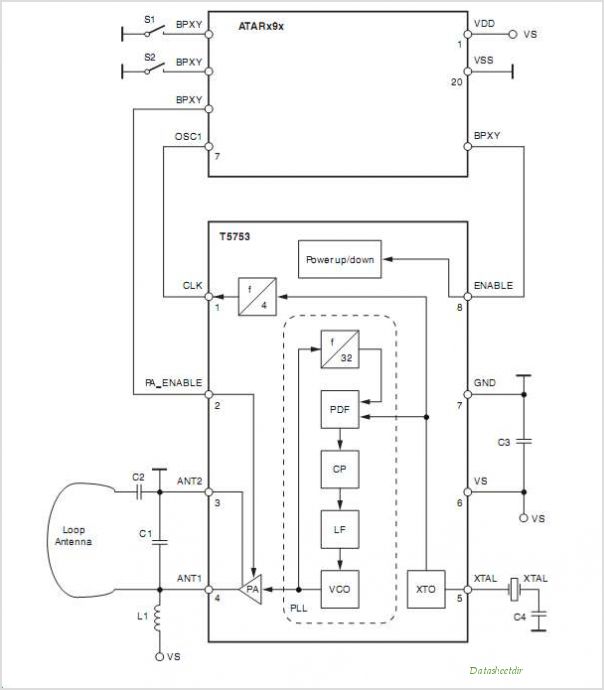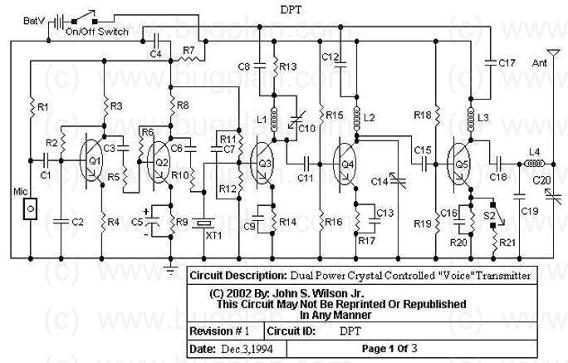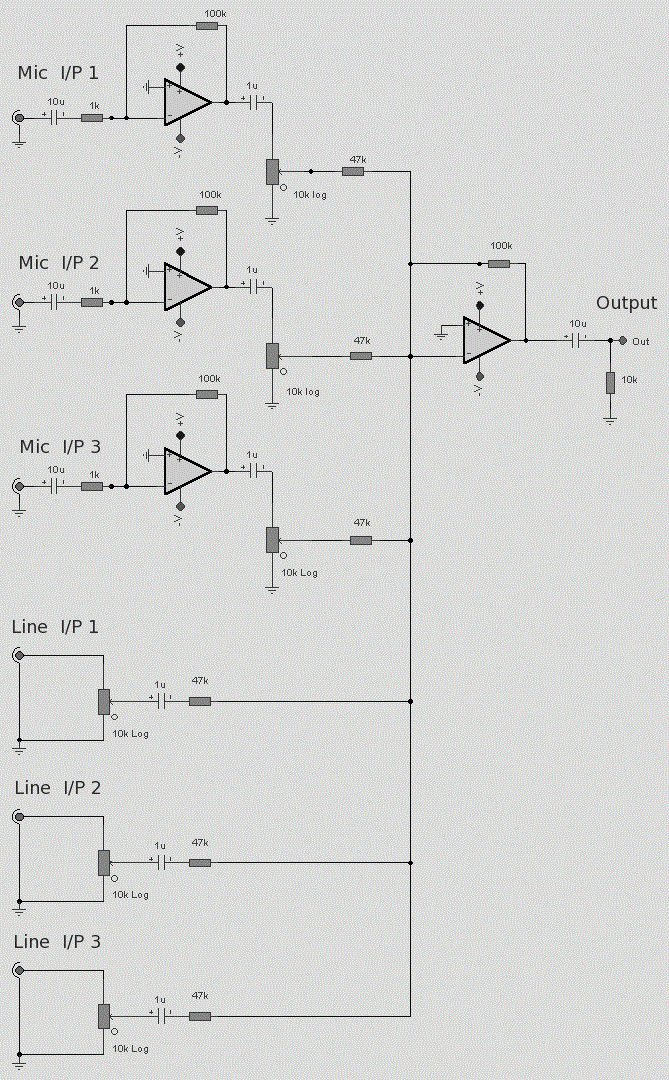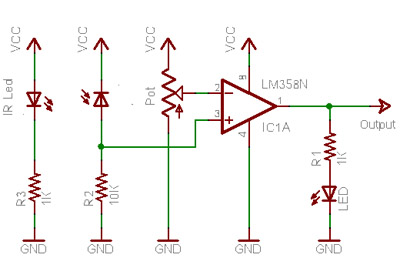
Digitally controlled FM transmitter with 2 line LCD display

Each step will result in a self-functional unit. By the end of this process, it will be possible to link the steps together into a powerful FM transmitter. This section will explain the main controlling unit for the FM transmitter, which is crucial since the transmitter frequency is digitally controlled, ensuring high stability. The PIC16F870 will remember the last frequency used, and when power is connected, the transmitter PLL and display will be updated first. If the frequency is not intended to be changed with buttons and no LCD display is desired, the initial frequency can be set while still using this controlling circuit. The simplest way to stabilize an RF oscillator is to implement a frequency regulating system. Without such a system, the oscillator's frequency may drift due to temperature changes or other influences. A common regulating system is the Phase-Locked Loop (PLL). In this design, the Voltage-Controlled Oscillator (VCO) operates within the range of 88 to 108 MHz. Energy is directed to both an amplifier and the PLL unit, which compares the VCO frequency with a stable reference frequency and regulates the VCO voltage to lock the oscillator at the desired frequency. The audio input also influences the VCO. The phase detector, shown in the accompanying diagram, has two inputs (A and B) and one output. The output of the phase detector acts as a current pump with three states: delivering constant current, sinking constant current, or remaining in a third state. The current pump can deliver both positive and negative current. Additional components include a VCO and a frequency divider (N divider) with a variable divider rate. For example, if the output voltage (Vout) is 0V, the VCO frequency (Fout) oscillates at approximately 88 MHz. This frequency is divided by 1800 (N divider), resulting in an output of about 48.9 kHz, which is fed to input B of the phase detector. The phase detector compares the two input frequencies; if A is higher than B, the current pump delivers current to the output loop filter. This current transforms into a voltage (Vout), which, as it rises, causes the VCO frequency (Fout) to increase. At 5V, the VCO frequency reaches 108 MHz, and after division by 1800, the frequency is approximately 60 kHz. When input B of the phase detector exceeds input A in frequency, the current pump begins to sink current from the loop filter, causing Vout to drop. The schematic should be consulted for a clearer understanding of the function described. The main oscillator is based around transistor Q1, which operates as a Colpitts oscillator. This oscillator is voltage-controlled to achieve FM (frequency modulation) and PLL control. A high-frequency transistor is preferred, but a common BC817 transistor is utilized effectively in this design. The oscillator requires an LC tank circuit to function properly, consisting of inductor L1, varicap diode D1, and capacitors C4 and C5 at the base-emitter of the transistor. The value of capacitor C1 determines the VCO range; a larger capacitance results in a wider VCO range. The capacitance of varicap D1 changes with the voltage applied across it, allowing for frequency modulation. A suitable varicap diode, such as the SMV1251, provides a capacitance range of 3-55 pF to ensure the VCO operates effectively within its designated range.
The FM transmitter's design incorporates a digital control mechanism, enabling precise frequency selection and stability through the use of a microcontroller (PIC16F870). This microcontroller not only retains the last used frequency but also initializes the PLL and display upon power-up, ensuring a user-friendly experience.
The PLL system is essential for maintaining frequency stability, particularly in RF applications where environmental factors can influence oscillator performance. The VCO, operating between 88 MHz and 108 MHz, is central to the transmitter's functionality. By employing a phase detector, the PLL continuously adjusts the VCO's output based on the comparison of its frequency with a stable reference, thus locking the frequency and minimizing drift.
The current pump within the phase detector plays a crucial role in this feedback loop, adjusting the voltage to the loop filter, which in turn influences the VCO's frequency. This dynamic interaction allows for real-time adjustments, ensuring that the transmitter remains locked to the desired frequency even under varying conditions.
The Colpitts oscillator configuration, utilizing the BC817 transistor, is designed to be both cost-effective and efficient. The LC tank circuit, consisting of the inductor and capacitors, is carefully selected to provide the necessary oscillation characteristics. The varicap diode's capacitance variation, controlled by the voltage across it, allows for effective frequency modulation, enabling the transmitter to respond to audio input signals.
Overall, this comprehensive design ensures that the FM transmitter operates reliably and efficiently, with an emphasis on stability, user control, and adaptability to various audio sources.Each step will result in a self functional unit. In the end of this journey, you will be able to link the steps together into a very powerful FM transmitter. This part will explain the main controlling unit for the FM transmitter. This part is very important since the transmitter frequency is digitally controlled and thereby very stable.
The PIC16 F870 will always remember the last frequency you used and when the power is connected, the first thing that happens is that the transmitter PLL and display will be uppdated. (If you never will change the frequency with the buttons and don`t want a LCD display, you can set the initial frequency and still use this controling circuit.
) The easiest way to make a RF oscillator stable is to implement some kind of frequency regulating system. Without any regulating system, the oscillator will start to slide in frequency due to temperature shift or other influences.
A simple and common regulating system is called PLL. In this construction the VCO range is 88 to 108 MHz. As you can see from the blue arrows, some energy goes to an amplifier and some energy goes to the PLL unit. What the PLL do is that it compare the VCO frequency with the reference frequency (which is very stable) and then regulated the VCO voltage to lock the oscillator at desired frequency.
The last part that will affect the VCO is the audio input. (Synthesizer and PLL can be broke down into complex regulating system with lot of math. I hope all PLL experts have indulgence with my simplyfied explanation below. I try to write so even fresh born homebrewers can follow me. ) The picture above shows you the phase detector. It has two inputs A, B and one output. The output of the phase detector is a current pump. The current pump has three states. One is to deliver a constant current and the other is to sink a constant current. The third state is a 3-state. You can see the current pump as a current delivery of positive and negative current. I have added a few parts to the system. A voltage controlled oscillator (VCO) and a frequency divider (N divider) where the divider rate can be set to any number. Let`s explain the system with an example: First the (Vout) is 0V and the VCO (Fout) will oscillate at about 88 MHz.
The frequency from the VCO (Fout) is divided with 1800 (N divider) and the output will be about 48. 9KHz. This frequency is feeded to the input B of the phase detector. The phase detector compares the two input frequencies and since A is higher than B, the current pump will deliver current to the output loop filter. The delivered current enters the loop filter and is transformed into a voltage (Vout). Since the (Vout) start to rise, the VCO (Fout) frequency also increases. At 5V the VCO (Fout) frequency is 108MHz and after the divider (1800) the frequency will be about 60kHz.
Now B input of the phase detector has higher frequency than A and the current pump starts to zink current from the loop filter and thereby the voltage (Vout) will drop. Please look at the schematic to follow my function description. The main oscillator is based around the transistor Q1. This oscillator is called Colpitts oscillator and it is voltage controlled to achieve FM (frequency modulation) and PLL control.
Q1 should be a HF transistor to work well, but in this case I have used a cheap and common BC817 transistor which works great. The oscillator needs a LC tank to oscillate properly. In this case the LC tank consist of L1 with the varicap D1 and the two capacitor (C4, C5) at the base-emitter of the transistor.
The value of C1 will set the VCO range. The large value of C1 the wider will the VCO range be. Since the capacitance of the varicap (D1) is dependent of the voltage over it, the capacitance will change with changed voltage. You can use many different varicap diod to get it working. In my case I use a varicap (SMV1251) which has a wide range 3-55pF to secure the VCO range ( 🔗 External reference
The FM transmitter's design incorporates a digital control mechanism, enabling precise frequency selection and stability through the use of a microcontroller (PIC16F870). This microcontroller not only retains the last used frequency but also initializes the PLL and display upon power-up, ensuring a user-friendly experience.
The PLL system is essential for maintaining frequency stability, particularly in RF applications where environmental factors can influence oscillator performance. The VCO, operating between 88 MHz and 108 MHz, is central to the transmitter's functionality. By employing a phase detector, the PLL continuously adjusts the VCO's output based on the comparison of its frequency with a stable reference, thus locking the frequency and minimizing drift.
The current pump within the phase detector plays a crucial role in this feedback loop, adjusting the voltage to the loop filter, which in turn influences the VCO's frequency. This dynamic interaction allows for real-time adjustments, ensuring that the transmitter remains locked to the desired frequency even under varying conditions.
The Colpitts oscillator configuration, utilizing the BC817 transistor, is designed to be both cost-effective and efficient. The LC tank circuit, consisting of the inductor and capacitors, is carefully selected to provide the necessary oscillation characteristics. The varicap diode's capacitance variation, controlled by the voltage across it, allows for effective frequency modulation, enabling the transmitter to respond to audio input signals.
Overall, this comprehensive design ensures that the FM transmitter operates reliably and efficiently, with an emphasis on stability, user control, and adaptability to various audio sources.Each step will result in a self functional unit. In the end of this journey, you will be able to link the steps together into a very powerful FM transmitter. This part will explain the main controlling unit for the FM transmitter. This part is very important since the transmitter frequency is digitally controlled and thereby very stable.
The PIC16 F870 will always remember the last frequency you used and when the power is connected, the first thing that happens is that the transmitter PLL and display will be uppdated. (If you never will change the frequency with the buttons and don`t want a LCD display, you can set the initial frequency and still use this controling circuit.
) The easiest way to make a RF oscillator stable is to implement some kind of frequency regulating system. Without any regulating system, the oscillator will start to slide in frequency due to temperature shift or other influences.
A simple and common regulating system is called PLL. In this construction the VCO range is 88 to 108 MHz. As you can see from the blue arrows, some energy goes to an amplifier and some energy goes to the PLL unit. What the PLL do is that it compare the VCO frequency with the reference frequency (which is very stable) and then regulated the VCO voltage to lock the oscillator at desired frequency.
The last part that will affect the VCO is the audio input. (Synthesizer and PLL can be broke down into complex regulating system with lot of math. I hope all PLL experts have indulgence with my simplyfied explanation below. I try to write so even fresh born homebrewers can follow me. ) The picture above shows you the phase detector. It has two inputs A, B and one output. The output of the phase detector is a current pump. The current pump has three states. One is to deliver a constant current and the other is to sink a constant current. The third state is a 3-state. You can see the current pump as a current delivery of positive and negative current. I have added a few parts to the system. A voltage controlled oscillator (VCO) and a frequency divider (N divider) where the divider rate can be set to any number. Let`s explain the system with an example: First the (Vout) is 0V and the VCO (Fout) will oscillate at about 88 MHz.
The frequency from the VCO (Fout) is divided with 1800 (N divider) and the output will be about 48. 9KHz. This frequency is feeded to the input B of the phase detector. The phase detector compares the two input frequencies and since A is higher than B, the current pump will deliver current to the output loop filter. The delivered current enters the loop filter and is transformed into a voltage (Vout). Since the (Vout) start to rise, the VCO (Fout) frequency also increases. At 5V the VCO (Fout) frequency is 108MHz and after the divider (1800) the frequency will be about 60kHz.
Now B input of the phase detector has higher frequency than A and the current pump starts to zink current from the loop filter and thereby the voltage (Vout) will drop. Please look at the schematic to follow my function description. The main oscillator is based around the transistor Q1. This oscillator is called Colpitts oscillator and it is voltage controlled to achieve FM (frequency modulation) and PLL control.
Q1 should be a HF transistor to work well, but in this case I have used a cheap and common BC817 transistor which works great. The oscillator needs a LC tank to oscillate properly. In this case the LC tank consist of L1 with the varicap D1 and the two capacitor (C4, C5) at the base-emitter of the transistor.
The value of C1 will set the VCO range. The large value of C1 the wider will the VCO range be. Since the capacitance of the varicap (D1) is dependent of the voltage over it, the capacitance will change with changed voltage. You can use many different varicap diod to get it working. In my case I use a varicap (SMV1251) which has a wide range 3-55pF to secure the VCO range ( 🔗 External reference
Warning: include(partials/cookie-banner.php): Failed to open stream: Permission denied in /var/www/html/nextgr/view-circuit.php on line 713
Warning: include(): Failed opening 'partials/cookie-banner.php' for inclusion (include_path='.:/usr/share/php') in /var/www/html/nextgr/view-circuit.php on line 713





